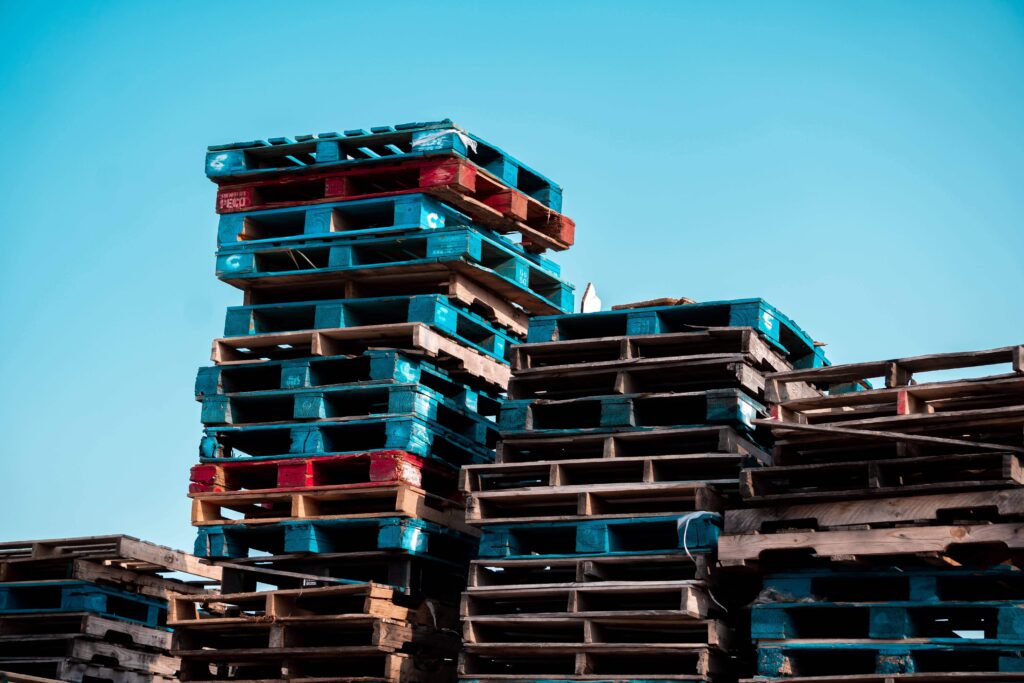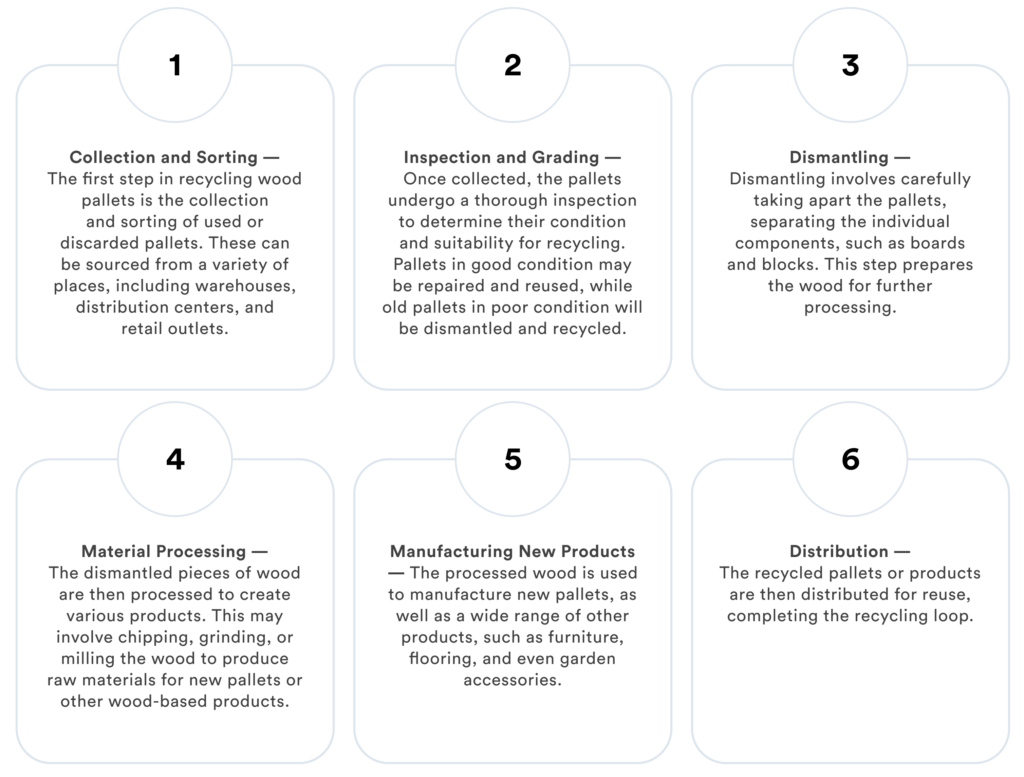In 2016, an estimated 849 million wooden pallets were produced, a 14% rise in overall production since 2011. This accounted for a massive 43% of hardwood and 15% of softwood lumber produced in the U.S, and while around 341 million pallets were recycled, 508 million were manufactured directly from raw materials. Today, it is estimated that nearly 2 billion pallets are in circulation each year, with a large proportion being replaced with new pallets once they reach the end of their lifecycle.
The good news is that these pallets have a few environmentally friendly credentials behind them, providing a reusable and recyclable way to transport bulk and large items. This includes streamlining the shipping of goods, being used multiple times before they reach the end of their service life, and being 100% recyclable. However, working against these factors is the sheer amount of material required for production, an imperfect pick-up and distribution system, and other issues such as the use of harmful chemicals and preservatives in their construction.
So, with more pallets than ever before in circulation, and a percentage of them inevitably falling out of pallet management systems and ending up in landfill, it’s worth taking a moment to understand why they should be reused, how they are recycled, and how you or your businesses can reuse unwanted pallets in a range of creative and useful ways. Read on to learn more.
Why Should You Return or Recycle Pallets?
Whether you received a new washing machine for your home, or your business bulk orders the supplies it needs, there are occasions when pallets fall outside of the usual collection and distribution systems. However, pallets are used on average around 5-10 times before they reach the end of their lifespan, so before you go ahead and think of a new use for it, double check that they’re not still part of the supply chain.
Additionally, it’s important to remember that most recycling centers are not equipped to deal with pallet disposal and recycling, and usually they will need to be sent to specialist wood pallet recycling centers for processing. These pallet recycling companies will have the tools and skills to require for refurbishing and recycling pallets effectively and efficiently.
However, even if your pallets are at the end of their lifecycle, or they are not part of the supply chain, there is a range of benefits to sending them back to specialist recycling services.
- Recycling wood pallets significantly reduces the demand for new timber, conserving natural resources and mitigating deforestation. It also helps decrease the amount of wood waste in landfills, contributing to more sustainable waste management systems.
- The energy required to recycle wood is considerably lower than that needed to produce new pallets from raw materials. By recycling pallets, you’re reducing energy consumption and lowering the associated carbon emissions.
- Choosing recycled pallets can mean cost savings for businesses, as they are often more affordable than newly manufactured pallets. This is an ideal option for companies operating on tight budgets or looking to allocate resources more efficiently.
- When wood pallets end up in landfill, they occupy valuable space and contribute to a range of environmental issues. By recycling pallets, less material ends up in landfill, which contributes to more sustainable waste management systems.
- The wood pallet recycling industry provides employment opportunities at various stages of the process, from collection and sorting to dismantling, repairs, and manufacturing. This contributes to local economies and fosters sustainable economic growth.
How Wood Pallet Recycling Works
Wood pallet recycling is a systematic process that aims to extract value from pallets that have reached the end of their service life. It usually includes the following steps:
Creative DIY Projects with Recycled Pallets
Finally, if you’ve checked that your pallets are either non-recyclable and past their recommended service life, you can start to get creative with them to reuse and repurpose them in ways that can benefit your business or improve your home! Below, we explore some of our favorites, but really, you’re only limited by your imagination.
Pallet Gardens
Vertical planters are a popular way to reuse pallets, providing a simple, space-saving and visually striking way to grow herbs, flowers, or succulents and build interesting landscaping features. You can stack them and affix them to the wall, or even use them to divide large open spaces both inside and out. When it comes to adding plants, line the gaps between the slats using natural materials such as cork or coco coir, alternatively, recycled plastic and fabric liners can be used. You can also add an automatic drip watering system, that not only saves you a job, but also saves on water.
Pallet Furniture
Pallets are the ideal material for unique and customized furniture pieces such as coffee tables, benches, or even bed frames. They’re usually extremely sturdy, and if they are a little damaged, they can easily be fixed with a few well-placed screws. What’s more, since pallets are found in standard sizes, they’re as easy to work with as Lego, and you can build almost any kind of furniture you like.
Pallet Shelving Units
Pallets can be combined to create versatile shelving units for storage or display purposes, allowing you to adapt the design to fit your space and style. Much like your vertical garden, you can attach them to the wall or leave them freestanding, and they can be arranged and rearranged in a variety of ways. If you want to pain them to match your existing décor, consider using non-toxic eco paints that avoid petrochemicals and other chemicals such as VOCs and APEs.
Pallet Compost Bins
Pallets make great composting bins that can help you or your business double down on your sustainability credentials. Simply place three pallets in a C shape in your chosen area and fix them together using screws and brackets. You can extend your bin as you need with more pallets, and even build compost lids that promote aeration while minimizing the chances that you pile will dry out in the hot summer months.
Pallet Lounges
Design comfortable outdoor seating areas that are modular and expandable to avoid buying new and ultimately reduce furniture waste. Outdoor sofas are ideal for gardens or even as customer seating areas for your business, and you can expand or take down your lounge whenever you need to. To make your creation even more sustainable, skip the chemical sealant, grab your blow torch and use Shou Sugi Ban to preserve the wood. What’s more you can now buy ready-made, rain resistant, sofa cushions created specifically for different pallet sizes.
Safety Precautions for Recycling Pallets
Finally, if you plan on using pallets for your projects, it’s important to take precautions and be safe while you work. Below we give you some advice on how to work safely with pallets.
- Consider what the pallet has been used for and where it has come from. Additionally, check the IPPC seal and look for a HT stamp. HT means heat treated, meaning the wood was sealed in kilns to protect it from invasive pests and pathogens. Other pallets may have been treated with methyl bromide, a toxic pesticide that you should avoid.
- Wear a mask and safety glasses whenever you’re cutting, sanding, or otherwise working on your pallet project. Additionally, work in a well-ventilated area to minimize exposure to dust and fumes.
- Use proper tools that are sharp and well maintained. Usually, pallet dismantling is done using a pry bar and hammer. However, a saber saw with a metal cutting blade can make short work of stubborn nails.
Conclusion
Pallets used for the shipping of goods, when used as part of a well managed pallet return and distribution system, offer a sustainable and resource-efficient way to safely transport a huge range of different items. However, that is not to say that the system is perfect, and wooden pallets use plenty of raw materials and create their own carbon footprint.
For these reasons, making the most of those pallets that don’t enter the recycling stream is a great way to reuse materials and ensure they stay out of landfill—helping to boost the circularity of these crucial distribution tools.
For more information on how your businesses can increase its sustainability and circularity, contact RTS today.


